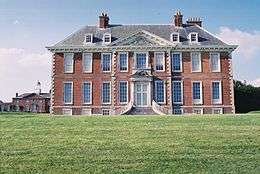Uppark
Coordinates: 50°57′11″N 0°53′30″W / 50.95306°N 0.89167°W



Uppark is a 17th-century house in South Harting, Petersfield, West Sussex, England and a National Trust property.
The house, set high on the South Downs, was built for Ford Grey (1655—1701), the first Earl of Tankerville, c.1690 and was sold in 1747 to Sir Matthew Fetherstonhaugh and his wife Sarah. Matthew and Sarah redecorated the house extensively from 1750 to 1760 and introduced most of the existing collection of household items displayed today, much of it collected on their Grand Tour of 1749 to 1751. Their only son, Sir Harry Fetherstonhaugh, added to the collection and commissioned Humphrey Repton to add a new pillared portico, dairy and landscaped garden. In the 19th century stables and kitchens were added as separate buildings, connected to the main building by tunnels.
On 30 August 1989 the building was devastated by a fire caused by a workman's blowtorch whilst repairing lead flashing on the roof, just two days before the work was due to be completed. The fire broke out during opening hours. Many works of art and pieces of furniture were carried out of the burning building by members of the Meade-Fetherstonehaugh family, National Trust staff and members of the public. Although the garret and first floors collapsed onto the lower floors and the garret and first floor contents were lost completely, the floors largely fell clear of the ground floor walls and much of the panelling and decoration survived. Much of the contents of the ground floor was crushed but not burned; metalwork was able to be straightened and cleaned, crystal chandeliers were able to be reassembled, and even the elaborate tassels on the chandelier ropes were able to be conserved. The decision to restore the house came after it was determined that restoration would be a cheaper insurance settlement than complete payout for a total loss.
Most of the pictures and furniture in the house were saved. The building has since been completely restored with many lost crafts relearned in the restoration process, and it re-opened its doors in 1995.[1]
H.G. Wells spent part of his boyhood at Uppark, where his mother, Sarah, was housekeeper between 1880 and 1893.[2] She had previously been employed there between 1850 and 1855, as housemaid to Lady Fetherstonhaugh's sister. Wells' father Joseph, a gardener, was employed at Uppark in 1851 and he and Sarah married in 1853.[3]
References
- ↑ Gillie, Oliver (19 July 1994). "Restoration of mansion consigns 1991 fire to faded memory". The Independent. Retrieved 2 June 2012.
- ↑ Nairn, Ian; Pevsner, Nikolaus (1965). The Buildings of England: Sussex. Harmondsworth: Penguin Books. pp. 358–60. ISBN 0-14-071028-0.
- ↑ H.G. Wells: Experiment in Autobiography
External links
| Wikimedia Commons has media related to Uppark. |
- Uppark information at the National Trust
- Historic England. "Details from image database (301802)". Images of England.